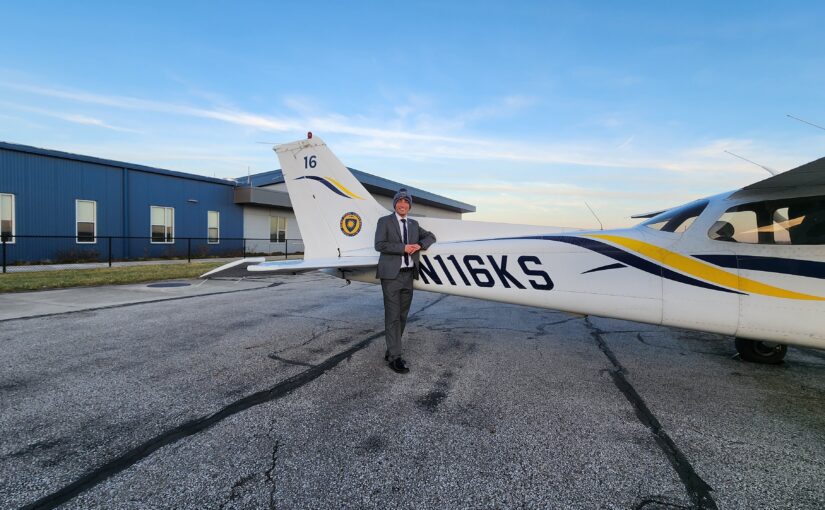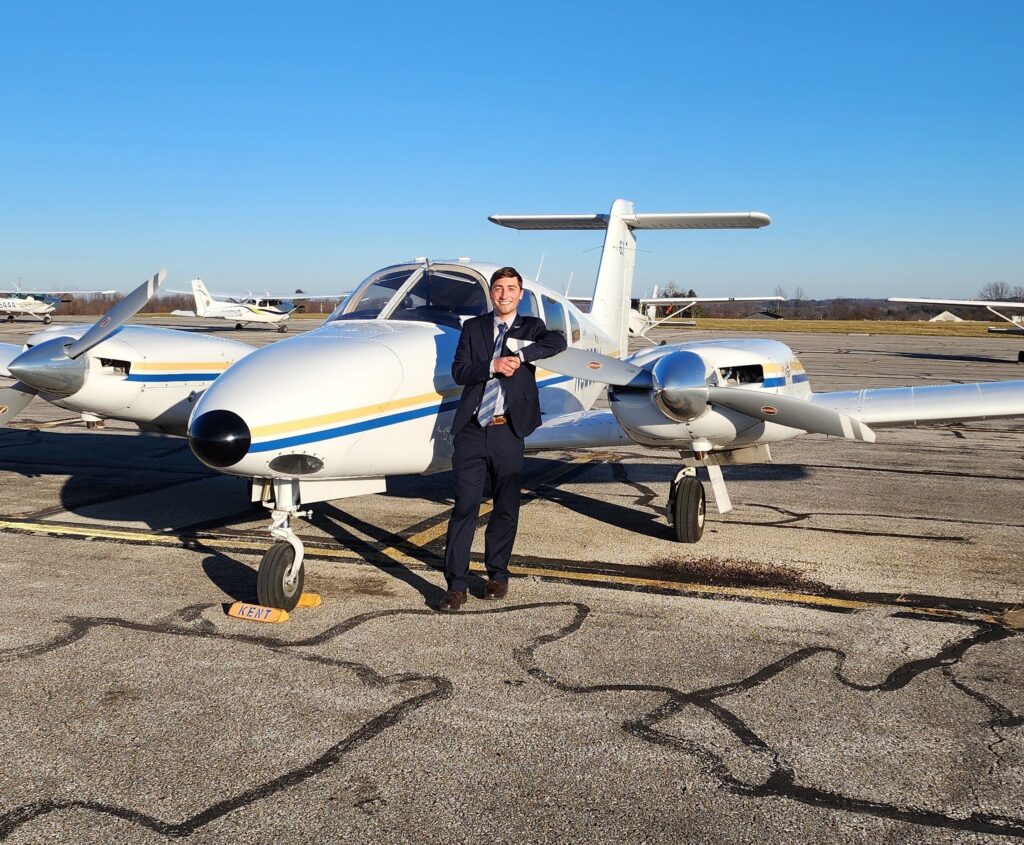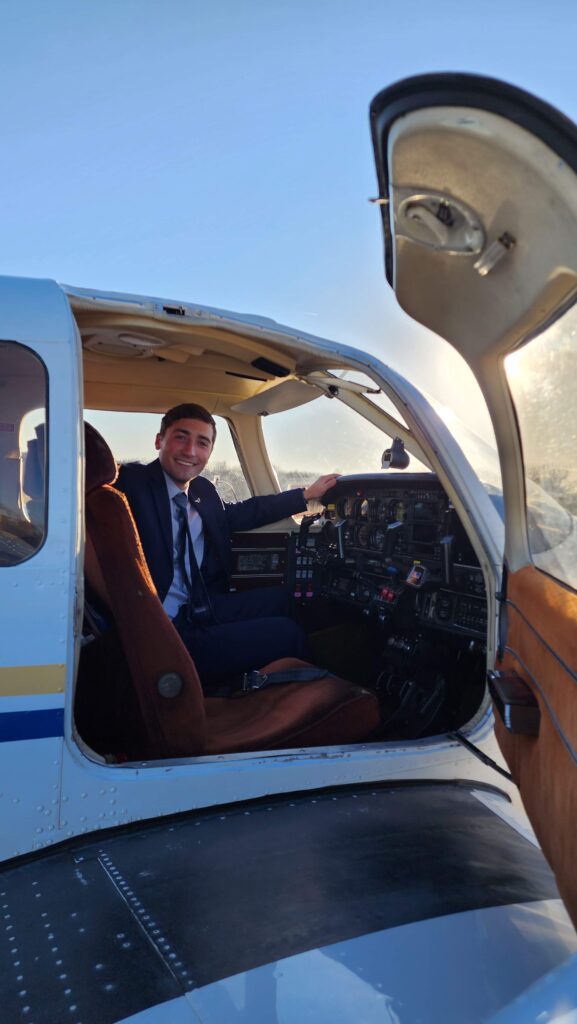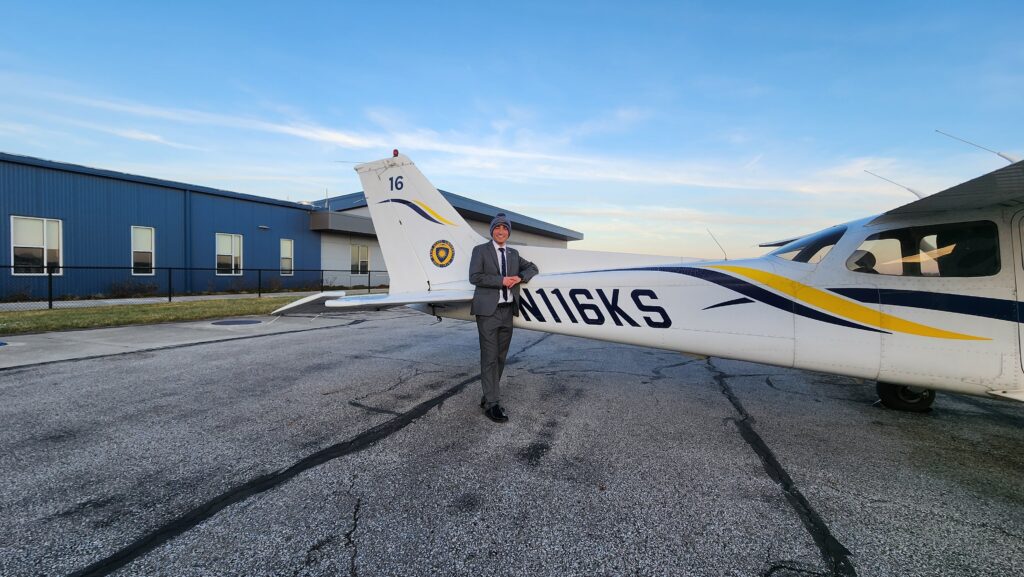Hello again everyone! After a very busy semester of flying, work, and classes, I finally have time to update everyone about my various adventures. I passed my Commercial Multi-Engine checkride on December 4! I had hoped to finish multi earlier in the semester, but my instructor left for the airlines and it took me a few weeks to get a new MEI because a lot of our previous MEIs had also left for the airlines. After I got a new MEI, I had a couple of review flights and was in for the checkride.
The oral was just over an hour long and was pretty straightforward. We first started going over some multi-definitions and then V speeds for the Piper Seminole. After that, we talked about multi-aerodynamics and the critical engine and why the left engine is the critical engine. We then moved onto systems, which made up most of the oral. Starting with the systems, we talked about the landing gear and it was pretty easy because it has the same landing gear as the Piper Arrow I had already been tested on. With the gear, I was given some scenarios about a hydraulic leak and where we would first see the indication. We then talked about what I would do if I only saw 2 gear-down indications which led to the microswitches on our aircraft. After the gear, we moved to the propeller. I was asked what keeps the prop from feathering and how we can change the pitch from feathered. After the propeller, we discussed the fuel tank which was the longest part of the questioning of the system. My DPE asked me to draw out the fuel system for the Seminole, which I was able to do with no problems. He then asked me some scenario questions about cross-feeding and what the fuel selectors would look like if we shut an engine down. To finish up the systems, we talked about the heater in our aircraft and how to turn it on and off both on the ground and in the air. After we completed the oral, we decided not to fly because of low ceilings. I took the oral exam on November 16th, so it was a couple more weeks until I was able to do the flight.
Nearly 3 weeks later due to the poor Ohio weather, a beautiful Sunday afternoon presented amazing weather for a checkride. After we started up and completed the run-up, I did a short field takeoff and headed to our SE practice area. Once we were about to cross into the practice area, my DPE moved the right engine’s fuel selector to the off position, and from there we did a full engine shutdown. Once my DPE was satisfied with my control on one engine, we restarted the engine and entered our area. In the area we did power on and off stalls, steep turns, slow flight and a Vmc Demo. All of these maneuvers went pretty well, especially my steep turns. My steep turn to the left was so good, my examiner tapped the altimeter to make sure it was still working. We then did an emergency descent down to 3,500’ and my DPE took the controls for a minute while I put on my foggles and got everything set up for the approach. We elected to do the RNAV 27 into KPOV. When we were on the base leg to intercept the final approach course, my left engine was pulled to idle and we conducted a single-engine approach. The approach went fairly well, getting no more than a 1 dot deflection at any point. After we landed, we took off again, but on this takeoff my engine was pulled to idle to simulate an engine failure on takeoff. We then actually took off and did a short field back into KPOV, where I nailed my point. I was really happy with this landing. We then took off and headed back to Kent, and I was finally a multi-engine rated pilot! The flight itself was 1.6 hours and there was nothing I hadn’t trained for.
In addition to receiving my Multi-Engine in December, I just earned my Certified Flight Instructor Certificate on January 15th! We did the oral on Saturday, January 14th, but had to discontinue due to low ceilings. We had originally planned on doing the flight on the following Wednesday because the weather over the next few days was forecasted to not be the best. On the 15th around noon, the examiner sent me a message asking if I wanted to do the flight at 2:30 since the weather was significantly better than forecasted. Of course I said yes, and quickly got ready to head to the airport.
The oral was only three and a half hours long and was one big scenario. The scenario started with the examiner portraying a role of a 60-year-old person wanting to become a pilot with no knowledge of flying, and I had to take him through all the steps needed to obtain his private pilot certificate. We first started off with the TSA endorsement, medical classes, durations, where to find an AME, and how to obtain a student pilot certificate. With the medical certificates, I was asked about disqualifying conditions, what a SODA is and what it can be used for. Staying with the aeromedical factors, we talked about the 4 types of hypoxia and the causes of each kind. In addition to hypoxia, we talked a lot about the gas laws like Fick’s Law, Boyle’s Law, Henry’s Law, and Dalton’s Law, and how they all related to hypoxia and the other aeromedical factors. Sticking with Henry’s Law, we talked about the rate of diffusion and how it can be related to flying. The main concern with this law was related to scuba diving and how it can cause “Bends”.
We then moved on to controlled field operations and runway safety. I had to walk my DPE through controlled field operations and how I would fly from Kent to Akron-Canton. We discussed runway sign markings, hotspots, and where to find more information about them in the chart supplement. In addition, we talked about Land and Hold Short Operations and who can accept them and LAHSO ops per Kent’s SOPs. Lastly, with controlled field ops, we talked about nonmovement areas and where we might find them.
Throughout the whole oral, I was asked about which endorsements I would give the student when they reach each milestone in their journey to become a private pilot. With that, we also talked about what endorsements I would need to give to a student if they were to fail the written or the practical exam. Regarding pilot certificates, we talked a little about category and class with respect to the airmen and the airplane. To end the logbook and endorsement section, we talked about who a CFI can endorse and what medical certificate a CFI needs to hold depending on who the CFI is instructing.
I was also asked some systems and aerodynamic questions. I was asked about the starter and the engine systems of our planes. I was asked to describe what happens when we turn the starter to “start” and describe the process with all of the solenoids, impulse coupler, etc. I was also asked some basic questions about the functionality of the engine, the components, and how everything was connected. With aerodynamics, I had to teach through the power curve and how we can use it in everyday flight.
As I took the oral exam, the fundamentals of instruction were spread throughout, covering professionalism, Maslow’s hierarchy of needs, laws of learning, defense mechanisms, and flight instructor responsibilities. Overall, I felt that the oral wasn’t that bad and was actually easier than my commercial and instrument checkride.
On the day of the flight, the weather conditions were perfect. We had light winds and clear skies. One thing special about this flight is that the student is able to decide what we do and when we do it. Our examiner lets us make a plan of action which has to cover all of the tasks, but we can choose what maneuvers we do and when we do them. I started out the flight by teaching through the engine start, taxiing, and uncontrolled field operations. I did a soft field takeoff out of Kent and walked through the departure procedures and the corridors. During our climb to the practice area, I put on my foggles and did constant airspeed climbs. At our cruising altitude, I discussed some of the possible emergencies, and then I did my first simulated engine failure into Portage of the flight. Everything was going well until I was about 2800’ MSL. There were two planes in the pattern which were not an issue, but there were two other planes that were also joining the pattern, and my examiner and I decided to go around and do the sim engine failure later. In the practice area, I did chandelles, power-off stalls, accelerated stalls, steep spirals, and turns around a point. We then headed back to Portage to do the short field landing. We did a short field takeoff from Portage, and when we were 550’ AGL, my examiner pulled my engine so I had to make the impossible turn. Thankfully, the 172R that I was flying loves to float, so the impossible turn was very possible. We landed about 1⁄3 of the way down the runway, made a 180 on the runway and departed again. We then headed back to Kent, discussed a few more emergencies, and did a soft field landing, and then I was now officially a CFI! I have already started CFII and my goal is to have it done in the next two months.
I’m still waiting to be hired by Kent as a CFI, but hopefully, that should happen within the next few weeks. I’m graduating in the spring and then from there, I will be instructing full-time until the Fall of 2024 when I will hopefully reach my 1,000 and be able to head to the airlines. I’m nervous to start teaching people how to fly, but at the same time, I’m excited to show new pilots just how amazing aviation is.





Congratulations on receiving your CFI certification! I really enjoyed reading about your checkflights and the nuances of each one. Seeing your story excites me to know that in just a short time I will be where you are today! Good luck to you on working towards your CFII!